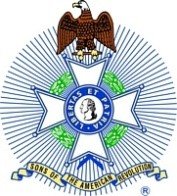Nathaniel Ames Chapter
The Nathaniel Ames Chapter was chartered on the second day of December, 1955. Its charter members were Grant M. Hyde (President), Bentley Courtenay (Vice President), Conrad D. Kohler (Secretary-Treasurer), Scotten K. Hale, Walter J. Kohler III, Robert Martin, Howard I. Miller, Voris A. Miller, Walter W. Miller and James P. Reed.
The Ames Chapter meets the third Thursday in January, March, May, September, and November at 6:00 p.m. Meeting locations vary. At this time it has 44 members. Please check the Calendar Page for meeting information (under construction). Members of the Ames Chapter participate in the State Society’s Color Guard and the Society’s Board of Directors.
Chapter Officers
President: William Austin
Vice President: Daniel Curd
Secretary: William A. Muether
Treasurer: Mike Nelson
Genealogist: Robert J. Stone
Our Namesake
Nathaniel Ames, Patriot
George Washington is well known to everyone. As a young man he was a surveyor and messenger in the wilderness. Later, he was a soldier and commander of the army. As President, he became our most beloved citizen. When he was a young man, Washington served with General Braddock, who was defeated by Wisconsin Indians under the command of Charles Langlade. Here is a story of George Washington and another Wisconsin citizen, Nathaniel Ames. Ames was a soldier, sailor, preacher and patriot. He lived the last years of his life in Wisconsin. Before he died, he told of his life.
Nathaniel Ames was born in Rhode Island in 1761. At six years of age he moved to Connecticut and was raised by his grandfather after his father was killed in the French war. He was a teenager when the Revolutionary War began, and at age 17 he served for one month as a guard on a ship. He also helped build Fort Griswold, which was near his home in Groton, Connecticut.
In 1779, Nathaniel joined the army. His enlistment was up in less than a year, then he joined General Huntington’s brigade. During the winter of 1779–80, Nathaniel was stationed with the army near Morristown, New Jersey. It was a time of terrible suffering. The weather was cold, soldiers lived in small log huts, and they had little warm clothing. Many had only straw for a bed, and each man had a single blanket for a covering. Some didn’t have shoes. The snow was deep and fell early in the autumn, lasting late into spring.
"We have," said George Washington, "had the patience of the army put to a test. Sometimes the men have been five or six days without bread. At other times as many days without meat. Once or twice, two or three days without either."
"At one time the soldiers ate every kind of horse food but hay. Buckwheat, wheat, rye, and Indian corn were ground into flour for bread."
"Washington," said Mr. Ames, "hearing of our suffering, came to the barracks. He looked in and spoke words of sympathy and encouragement. We told him we hoped to live until spring. We were eager to fight our country’s battles."
In the fall of 1780, the young soldier returned home again. He joined the crew of the ship La Fayette (it had sixteen guns). The ship sailed to Newport, Rhode Island, when a French fleet entered the harbor at the same time. These ships carried soldiers and had come to help the Americans. Nathaniel remembered both seeing and hearing these men. They wore wooden shoes, and when they marched they made a loud tramping sound.
British vessels dropped anchor outside the harbor. The La Fayette could not leave, then George Washington visited the town and welcomed the Frenchmen. Nathaniel was proud to see Washington again. When the La Fayette was finally able to leave port, Nathaniel sailed on several of her voyages. On one trip the ship was captured and the crew were taken to Bermuda. They spent three months on the island.
When the Revolutionary War ended in 1783, Nathaniel joined the crew of another ship. He traveled all over the world, but he became sick with yellow fever and nearly died. Returning home, Nathaniel went to school for a time. He married Sarah Hall and became a farmer. Then, at 30, he became a Methodist preacher. The family moved to Steuben, New York, where Nathaniel preached for forty-five years. Then, at the age of 75, he moved to Wisconsin with his wife and three of his children and bought a farm near Oregon in Dane County. Mrs. Ames died at 89.
In 1859, a friend asked, "Do you remember Washington?" "Yes," replied Nathaniel, "and old Steuben, too." He paused and thought back through the years. He remembered the excitement and suffering of the war. Big tears rolled down his aged cheeks. Then he added, "You must excuse these tears. For I can never think of these good men without causing my heart to be stirred within me."
Nathaniel Ames, patriot, died in 1863. Years later, special ceremonies were held at his grave. In 1924 the EvansvilleNathaniel Ames Masonic Memorial Masonic Lodge erected a monument to this patriot in the Prairie Mound Cemetery at Oregon. That year, the Daughters of the American Revolution also put a marker there, which two of Nathaniel’s great-great grandsons unveiled. An official Wisconsin Historical Marker was placed at the Prairie Mound Cemetery honoring Patriot Ames on April 20, 2002.
WISSAR is most thankful to Shirley Anderson Erfurth who furnished the portrait of Nathaniel Ames. She is a direct descendent of Nathaniel Ames through her mother Marion Ellis Anderson. Marian's mother was Sadie Ames Ellis. Sadie's father was Francis Marion Ames. Francis was the son of John Norton Ames. John Norton's father was David Ames who was Nathaniel's son.
Source: The State Historical Society of Wisconsin, The Revolutionary Years, 1750-1815.

